China
-
- South China Sea Arbitration: Implications for Maritime and O&G Maritime Reporter, Oct 2016 #14
A recent decision by an international tribunal in The Hague, Netherlands, has significant implications for other maritime disputes, freedom of navigation, and future oil and gas claims in the Arctic.
The arbitral award issued on July 12, 2016, by a unanimous five-member panel or Permanent Court of Arbitration (PCA) in the dispute between the Philippines and China over rocks and elevations in the South China Sea, sounded a clarion call for the rule of law and the clearly defined maritime boundaries and environmental principles established by the United Nations Convention on Law of the Sea (Convention). It remains to be seen whether China will abide by the decision and enter into negotiations with the Philippines to resolve all remaining disputes to these territories and waters. To date, China, which never participated or recognized the authority of the PCA to arbitrate this case, has rejected the ruling and is continuing to build up its military presence in the region.The DisputeBoth the Philippines and China are parties to the Convention, which requires that parties to maritime disputes resolve them through arbitration. The dispute essentially revolved around China’s drawing of a so-called “nine-dash-line” around several outcroppings in the South China Sea that borders both China and the Philippines. China claimed that it had historical rights to these outcroppings and that no tribunal under the Convention could rule on its alleged sovereignty to this territory. Tired of having their fishermen harassed in open waters, and their vessels being harassed by Chinese law enforcement vessels, in 2013, the Philippines brought this dispute to the Hague in claiming that China was interfering with traditional Philippine fishing activities at Scarborough Shoal, an island in the South China Sea; that China had no “historic rights” with respect to the maritime areas of the South China Sea; that China had violated its duties under the Convention to protect and preserve the marine environment; that China had breached its obligations under the Convention by operating its law enforcement vessels in a dangerous manner causing serious risk of collision to Philippine vessels navigating in the vicinity; and that the reefs that China had claimed as low-tide elevations did not generate any entitlement to an exclusive economic zone or continental shelf. The Philippines were well-represented by a team of skilled U.S. lawyers, while China refused to attend or participate in the PCA’s deliberations because of its position that the tribunal could not rule on matters of sovereignty, which China claimed over all islands and reefs in the South China Sea, including the Spratly Islands and Scarborough Shoal. [See map left.]The RulingThe PCA first had to determine whether it had jurisdiction to hear the dispute. The PCA found that it did so because the dispute was not over territorial sovereignty—over which they admittedly had no jurisdiction—but was a dispute under the Convention over maritime boundaries and protection of the marine environment.The PCA turned next to the merits of the case and found that China’s claim to historic rights to resources and waters of the South China Sea was fundamentally incompatible with the allocation of rights and establishment of maritime zones in the Convention. Significantly, if China had any historic rights to resources and waters of the South China Sea, these rights were extinguished by the entry into force of the Convention and were incompatible with the Convention’s system of maritime zones, i.e., 12-mile territorial seas, and 200-mile Exclusive Economic Zones (EEZ). As a party to the Convention, China has accepted these boundaries.The next question was whether the outcroppings in the South China Sea were entitled to a territorial sea or EEZ. The PCA found that certain reefs were above water at high tide; therefore they were entitled to a 12-mile territorial sea. However, other outcroppings claimed by China as having their own EEZ—encircled by the nine-dash-line—did not because they could not sustain human habitation or economic life on their own, despite China’s efforts to place runways and other buildings on these islands. Although Chinese and other fishermen had used the Spratly Islands, this temporary usage did not amount to habitation by a stable community and therefore these features are just “rocks” that do not generate an EEZ or continental shelf. Finally, the Tribunal concluded that China had violated its duty to respect the traditional fishing rights of Philippine fishermen by halting their access to Scarborough Shoal after May 2012, and that its large-scale land reclamation and construction of artificial islands at seven features in the Spratly Islands had caused severe harm to the coral reef environment, thus violating China’s obligations under the Convention to preserve and protect the marine environment. Regrettably, the PCA cannot enforce its award so it is up to China to decide how to react. So far, the reaction has been fairly negative and China is continuing to operate patrols there, sending its aircraft to the Spratly Islands, and once again using Chinese coast guard ships to block access by Philippine fishermen to the Scarborough Shoal.Implications for U.S. Shipping and O&G Exploration in the ArcticAn estimated $5.3 trillion of maritime commerce passes through the South China Sea every year as a major shipping route between China, Japan, South Korea, Europe, and the Middle East. Should China choose to impede the rights of innocent passage and freedom of safe navigation, according to Esben Poulsson, President of the Singapore Shipping Association, this “would potentially drive up shipping costs, resulting in a detrimental impact on maritime trade.”Although no U.S.-flag vessel has been harassed to date by Chinese vessels, the United States is taking no chances and is sending its own ships to patrol the open waters of the South China Sea. On August 6, amphibious assault ship USS Boxer completed a routine patrol in international waters of the South China Sea in order to “help promote the rights, freedoms, and lawful uses of the sea and airspace guaranteed to all countries,” according to Captain Patrick Foege, commander of U.S. Navy Amphibious Squadron 1. Some Members of Congress, including Senator Dan Sullivan (R-AK), are calling on the United States to send two aircraft carriers there on a permanent basis to protect the fundamental right enshrined in the Declaration of Independence of freedom of navigation. (From a keynote speech of Senator Sullivan on July 12, 2016, at the 6th Annual South China Sea Conference of the Center for Strategic and International Studies.)Impacts of the Ruling on Other ClaimsNow that the PCA has made clear the obligation of parties to the Convention to abide by its principles and boundaries, it is more important than ever for the United States to ratify the Convention, which creates not only a 200-mile EEZ but also an extended continental shelf out to 350 miles. This is critical if the United States wants to protect its claims to the vast oil and gas resources of the outer Continental Shelf (OCS) in the Arctic and counter claims of other nations, e.g., Russia, that may interfere with its own claims based on the U.S.-extended continental shelf adjacent to Alaska.Russia and more than fifty other nations have staked their claims to an extended OCS by filing submissions to the Commission on the Limits of the Continental Shelf pursuant to Article 76 of the Convention. The United Nations was prepared to consider Russia’s claims this summer during the Commission’s 41st session. The United States is an observer at the Commission proceedings, but since it is not a party to the Convention, it has no official role there. While the United States can claim to and does abide by maritime principles under the Convention as a matter of customary international law, it will have better standing in the world to protect its own and other countries’ legitimate maritime boundaries and encourage China to abide by the rule of law if the United States is itself a party to the Convention.Oil and gas companies and their respective trade associations and many other groups have long urged the United States to ratify the Convention; it is time for the Senate to quickly and responsibly do so.The benefits of ratification clearly outweigh any perceived costs.
The AuthorJoan Bondareff, Of Counsel at Blank Rome LLP, focuses her practice on marine transportation, environmental, and legislative issues and represents clients in many industries and state and local governments. -
- Choke Points are Flash Points Maritime Reporter, Sep 2016 #28
The world is closely watching several contentious flash points that have potential to ignite. The behavior and rhetoric of China and Russia regarding vital shipping lanes in international waters have been alarming. Disputed sovereignty claims and efforts to enforce them have the maritime world on edge.
-
- Cruise Ship Construction: China Rising Maritime Reporter, Jun 2018 #41
China earns cruise newbuild business, aims for ship financeWhile China has steadily built shipbuilding market share, cruise ship construction – more specifically mastering the logistical complexities inherent in cruise ship design, outfit and construction – has proved elusive. But it appears that Chinese
-
- China: Growing Influence in All Matters Maritime Maritime Reporter, Nov 2003 #52
China's importance in the world maritime market has accelerated rapidly over the past decade, but it appears that current and near future growth will prove even more prolific. Chinese shipyards for 10 years have continued to dent the market share numbers of major shipbuilders in Japan. Korea and
-
- Opinion: Maritime Freedom & the Global Commons Maritime Reporter, Mar 2020 #72
, sea lines of communication, access to world markets, and diplomatic partnerships. However, it is becoming increasingly alarming that nations such as Iran, China and Russia seek to accumulate/consolidate power and re-define international maritime norms, potentially at the peril of diplomatic, economic, and military
-
- Cruise Industry Seeks Fortune in China Maritime Reporter, Feb 2015 #24
over the last three months by the world’s largest cruise liner company, Carnival Corp., with the largest cruise ship builder, Fincantieri S.p.A.; with China’s largest shipyard, China State Shipbuilding Corp. (CSSC); and with state agency China Merchant Group, which is focused on transportation, infrastructure
-
- Shiport China 2004: Set in Tune with the Shipbuilding Industry Maritime Reporter, Nov 2003 #57
Shiport China 2004, the 4th International Ship Building, Port and Marine Technology and Transportation Equipment Exhibition for China, is scheduled for June 22-25, 2004 at the Dalian Xinghai Convention & Exhibition Centre. Dalian. Anticipated to draw more than 30,000 quality buyers, the event will
-
- New Joint Venture Formed For China's International Maritime Exhibition Maritime Reporter, Sep 1988 #65
The Cahners Exposition Group (CEG) and the Seatrade Organisation recently announced the formation of a joint venture company to organize China's international maritime exhibition, "Marintec China" and "Marintec Offshore China," which has been held in Shanghai every two years since 1981. The event
-
- U.S. Navy Asserts “Freedom of Navigation” in the South China Sea Maritime Reporter, Aug 2021 #16
the western Pacific, where the United States Navy continues to assert its right to operate freely in international waters by conducting FONOPS in the South China Sea, particularly in the vicinity of the Spratly and Paracel Islands. USS Benfold (DDG 65) conducted a FONOP in the South China Sea on July 12
-
- Opportunities for Growth as Chinese Economy Evolves Maritime Reporter, Nov 2015 #34
and project cargo shipments, in conjunction with the significant growth in renewable projects that we are also seeing in Europe and beyond. However, it is China – as the most conspicuous industrial trader – that provides an insightful look in terms of what is changing in the multi-purpose segment, and the challenges
-
- Boatbuilding in China Maritime Reporter, Apr 2015 #90
month to explore activities in select boatbuilding sectors. Damen Yichang Shipyard The Damen boatbuilding name is ubiquitous around the world, and China is certainly no exeception. The Damen Yichang Shipyard in China started ops in 1999 as a JV between Damen Shipyards Group and Sinotrans CSC, focused
-
- China's Emerging Ship Repair Leader Maritime Reporter, Jan 2017 #42
Engineering News interviews Chen Yong president Zhoushan IMC YongYue Shipyard Engineering Co., (IMC-YY) an emerging leader in ship repair and conversion in China. For our readers not familiar with IMC-YY, can you describe your physical facilities? Houshan IMC-Yougyue Shipyard & Engineering’s success starts
-
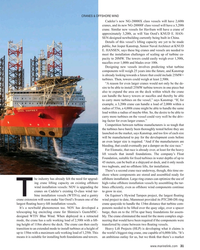 )
April 2024 - Maritime Reporter and Engineering News page: 31
)
April 2024 - Maritime Reporter and Engineering News page: 31new vessels for Havfram will have a crane of approximately 3,200t, as will Van Oord’s KNUD E. HAN- SEN-designed newbuilding currently being built in China. Details of this vessel’s lifting capacity are yet to be made public, but Jesper Kanstrup, Senior Naval Architect at KNUD E. HANSEN, says these big
-
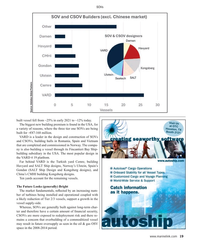 )
April 2024 - Maritime Reporter and Engineering News page: 19
)
April 2024 - Maritime Reporter and Engineering News page: 19VARD is the Turkish yard Cemre, building Havyard and SALT Ship designs, Norway’s Ulstein, Spain’s Gondan (SALT Ship Design and Kongsberg designs), and China’s CMHI building Kongsberg designs. Ten yards account for the remaining vessels. The Future Looks (generally) Bright The market fundamentals, re? ected
-
 )
April 2024 - Maritime Reporter and Engineering News page: 18
)
April 2024 - Maritime Reporter and Engineering News page: 18demand for ad- Given that SOVs and CSOVs operate in a segment target- ditional CSOVs. ing reduced emissions, and many operate in the North Eu- Outside of China, the Asia Paci? c region is in the early ropean segment, characterized by a general strengthening of stages of wind farm development, with one active
-
 )
April 2024 - Maritime Reporter and Engineering News page: 17
)
April 2024 - Maritime Reporter and Engineering News page: 17SOVs China, we do not look at demand for SOVs/CSOVs as having a linear rela- tionship to the number of wind farms or turbines installed. We look to see where a large number of wind turbines are concentrated in relatively close proximity, generally in a very large wind farm or in a project cluster
-
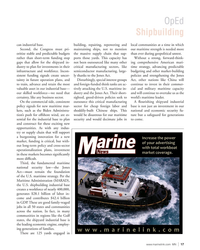 )
April 2024 - Marine News page: 17
)
April 2024 - Marine News page: 17the Jones Act. policies and strengthening the Jones tainty in future operation plans, and Disturbingly, special interest groups Act, other nations like China will to train, advance and retain the most and foreign-funded think tanks are ac- continue to invest in their commer- valuable asset in our industrial
-
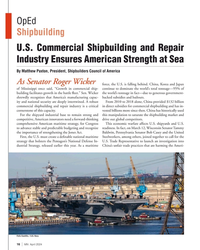 )
April 2024 - Marine News page: 16
)
April 2024 - Marine News page: 16Ensures American Strength at Sea By Matthew Paxton, President, Shipbuilders Council of America As Senator Roger Wicker force, the U.S. is falling behind. China, Korea and Japan of Mississippi once said, “Growth in commercial ship- continue to dominate the world’s total tonnage—95% of building facilitates
-
 )
February 2024 - Maritime Reporter and Engineering News page: 13
)
February 2024 - Maritime Reporter and Engineering News page: 13shipping companies are facing something of a per- fect storm in 2024 with the Red Sea attacks, potential escala- tion of tensions between the US and China in the South China Sea (which could impact trade routes further) and even some signs of piracy returning around Somalia. Business Interruption Rounding
-
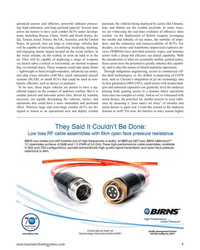 )
January 2024 - Marine Technology Reporter page: 9
)
January 2024 - Marine Technology Reporter page: 9many ways, actors are known to have such combat AUVs under develop- we are witnessing the real-time evolution of offensive mine ment, including Russia, China, North and South Korea, In- warfare via the deployment of hybrid weapons leveraging dia, Taiwan, Israel, France, the UK, Australia, and the United
-
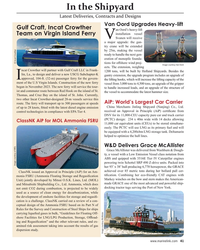 )
January 2024 - Maritime Reporter and Engineering News page: 41
)
January 2024 - Maritime Reporter and Engineering News page: 41other Incat Crowther-designed 28-m vessels service this AiP: World’s Largest Car Carrier route. The ferry will transport up to 300 passengers at speeds China Merchants Jinling Shipyard (Nanjing) Co., Ltd. of up to 28 knots, ? tted with the latest diesel engine emission received an Approval in Principle
-
 )
January 2024 - Maritime Reporter and Engineering News page: 40
)
January 2024 - Maritime Reporter and Engineering News page: 40be delivered in Q2 2026. Austal USA Wins USN EMS Contract CO2 Tanker Ordered Bernhard Schulte ordered its ? rst CO2 tanker, a newbuild to be built in China at Dalian Shipbuilding Offshore (DSOC). Planned for delivery in 2026, the ship will have a capacity of 7,500 cu. m. liquid CO2 in a pair of cylindrical
-
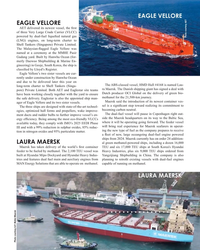 )
December 2023 - Maritime Reporter and Engineering News page: 39
)
December 2023 - Maritime Reporter and Engineering News page: 39vessel was Heavy Industries, plus six 9,000 TEU ships ordered from built at Hyundai Mipo Dockyard and Hyundai Heavy Indus- Yangzijiang Shipbuilding in China. The company is also tries and features dual fuel main and auxiliary engines from planning to retro? t existing vessels with dual-fuel engines MAN
-
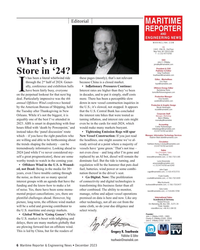 )
December 2023 - Maritime Reporter and Engineering News page: 6
)
December 2023 - Maritime Reporter and Engineering News page: 6has been a literal whirlwind ride these pages (mostly), that’s not relevant Editor - MarineNews nd Eric Haun through the 2 half of 2024. Gener- because China is a closed market. [email protected] ally, conference and exhibition halls • In? ationary Pressures Continue: Offshore Energy Editor Bartolomej
-
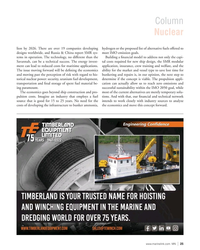 )
November 2023 - Marine News page: 25
)
November 2023 - Marine News page: 25by 2026. There are over 19 companies developing hydrogen or the proposed list of alternative fuels offered to designs worldwide, and Russia & China report SMR sys- meet IMO emission goals. tems in operation. The technology, no different than the Building a ? nancial model to address not only
-
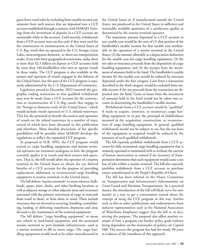 )
November 2023 - Marine News page: 19
)
November 2023 - Marine News page: 19withdrawals from a CCF account to purchase replacement, additional, or reconstructed cargo handling cranes manufactured in the People’s Republic of China. equipment at marine terminals in the United States. The bill has been referred to the House Committee The bill de? nes “marine terminals” to mean
-
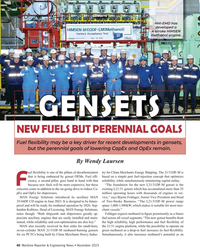 )
November 2023 - Maritime Reporter and Engineering News page: 40
)
November 2023 - Maritime Reporter and Engineering News page: 40gensets, but the perennial goals of lowering CapEx and OpEx remain. By Wendy Laursen uel ? exibility is one of the pillars of decarbonization try for China Merchants Energy Shipping. The 21/31DF-M is that is being embraced by genset OEMs. Fuel ef? - based on a simple port fuel-injection concept that
-
 )
November 2023 - Maritime Reporter and Engineering News page: 23
)
November 2023 - Maritime Reporter and Engineering News page: 23chains were unable to respond. New demand training has not kept pace with changes coming to the equipment from Asia was likely to lead recovery even if China’s role and alternative fuels they will use in future, Schellenberger said. switched from production of goods to a buyer of them. One in three seafarers
-
 )
November 2023 - Maritime Reporter and Engineering News page: 8
)
November 2023 - Maritime Reporter and Engineering News page: 8Offshore Operations 689.7 49 (By Country) United States of America 8,386.2 894 Norway 3,319.1 216 Brazil 3,257.6 248 Singapore 2,754.9 483 China 2,571.0 450 Top OSV Buying Companies (Spend) Buyer Company Spend ($) # Vessels Tidewater Marine 596.7 38 Britoil Offshore 236.8 29 Hornbeck Offshore
-
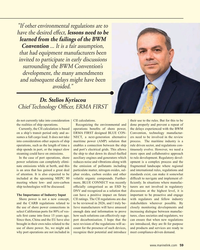 )
August 2023 - Maritime Reporter and Engineering News page: 59
)
August 2023 - Maritime Reporter and Engineering News page: 59between manufac- sels ? rst came into force 15 years ago. how such solutions can effectively sup- tures, class societies and regulators, we Since then, China and the EU have also port decarbonisation. I hope that the can ensure that when new regulations brought in their own rules related to the next
-
 )
August 2023 - Maritime Reporter and Engineering News page: 48
)
August 2023 - Maritime Reporter and Engineering News page: 48. So, we are very proud to six 9,000 TEU ships ordered from Yangzijiang Shipbuilding in have achieved this signi? cant milestone. We expect a diverse China. The company is also planning to retro? t existing vessels green fuel mix for the future, with green bio-methanol from with dual-fuel engines capable
-
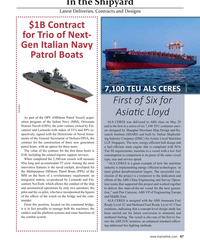 )
August 2023 - Maritime Reporter and Engineering News page: 47
)
August 2023 - Maritime Reporter and Engineering News page: 47requirement: an clusion of the project is a testament to the dedication and integrated station, co-produced by Leonardo and Fin- efforts of the ABS China Engineering and Survey Opera- cantieri NexTech, which allows the conduct of the ship tion teams that supported this project and worked together and
-
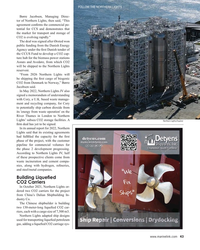 )
August 2023 - Maritime Reporter and Engineering News page: 43
)
August 2023 - Maritime Reporter and Engineering News page: 43, and steel/metal companies. Building Lique? ed CO2 Carriers In October 2021, Northern Lights or- dered two CO2 carriers for the project from China’s Dalian Shipbuilding In- dustry Co. The Chinese shipbuilder is building two 130-meter-long lique? ed CO2 car- riers, each with a cargo size of 7
-
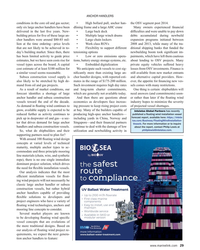 )
August 2023 - Maritime Reporter and Engineering News page: 29
)
August 2023 - Maritime Reporter and Engineering News page: 29to producing high-spec anchor handlers— forecast report, available here: https://intela- pick up in deepwater oil and gas—a sec- including yards in China, Norway and tus.com/Business/FloatingWindInstallation- tor that drives demand for large anchor Singapore—and their ? nancial partners Vessels.
-
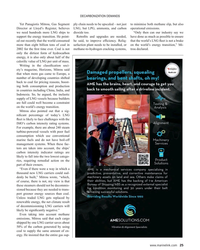 )
August 2023 - Maritime Reporter and Engineering News page: 25
)
August 2023 - Maritime Reporter and Engineering News page: 25to Europe, a number of developing countries shifted back to coal for pricing reasons, boost- ing both consumption and production in countries including China, India, and Indonesia. So, he argued, the inelastic supply of LNG vessels because builders are full could well become a constraint on the world’s
-
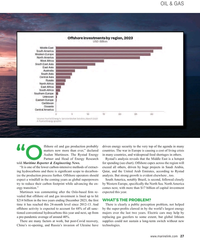 )
May 2023 - Maritime Reporter and Engineering News page: 27
)
May 2023 - Maritime Reporter and Engineering News page: 27to some extent, but global lithium There are many factors at work, but post-Covid recovery, supplies could not sustain a long-term switch without new China’s re-opening, and Russia’s invasion of Ukraine have technologies. www.marinelink.com 27 MR #5 (18-33).indd 27 5/1/2023 10:04:12 A
